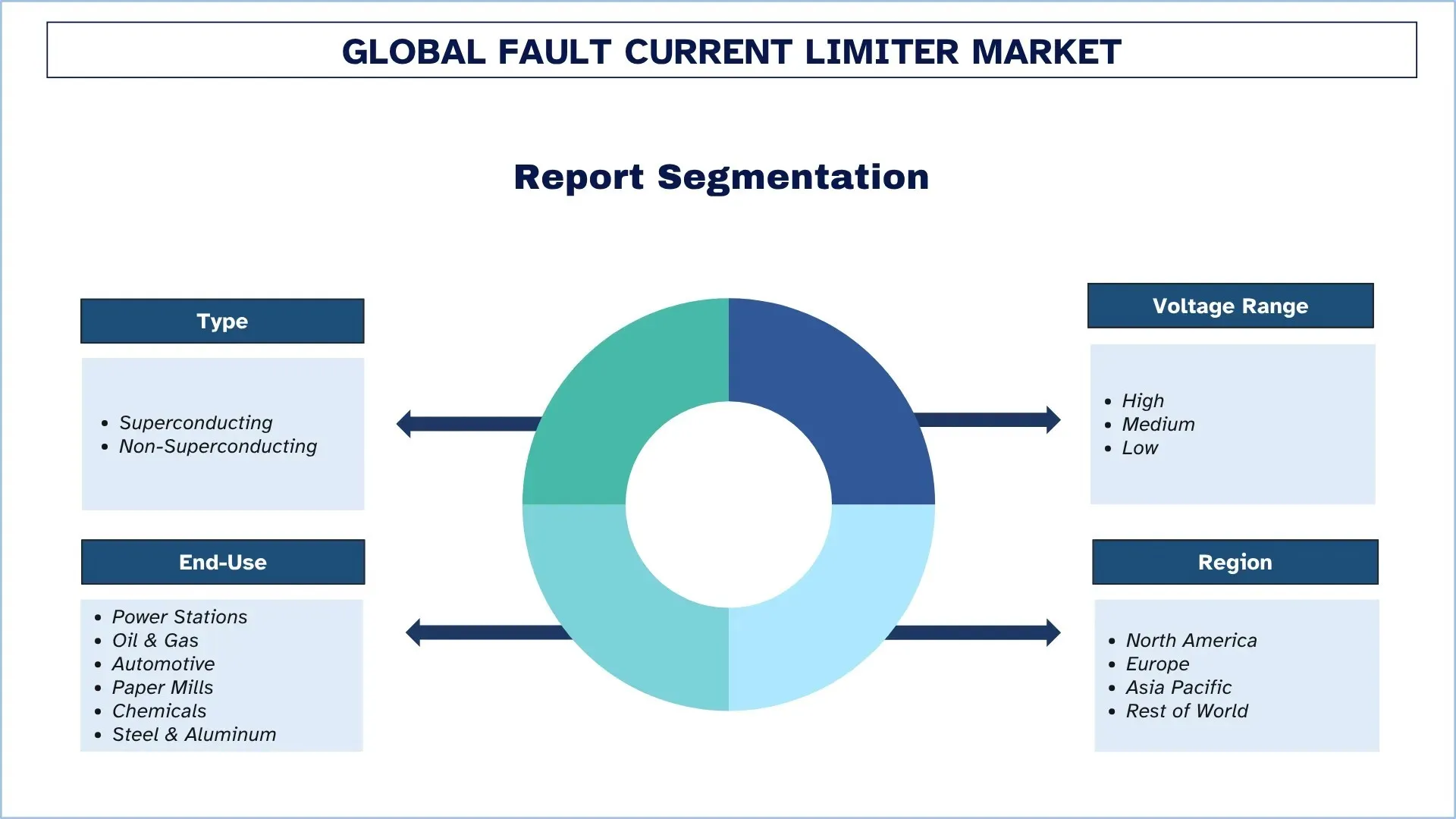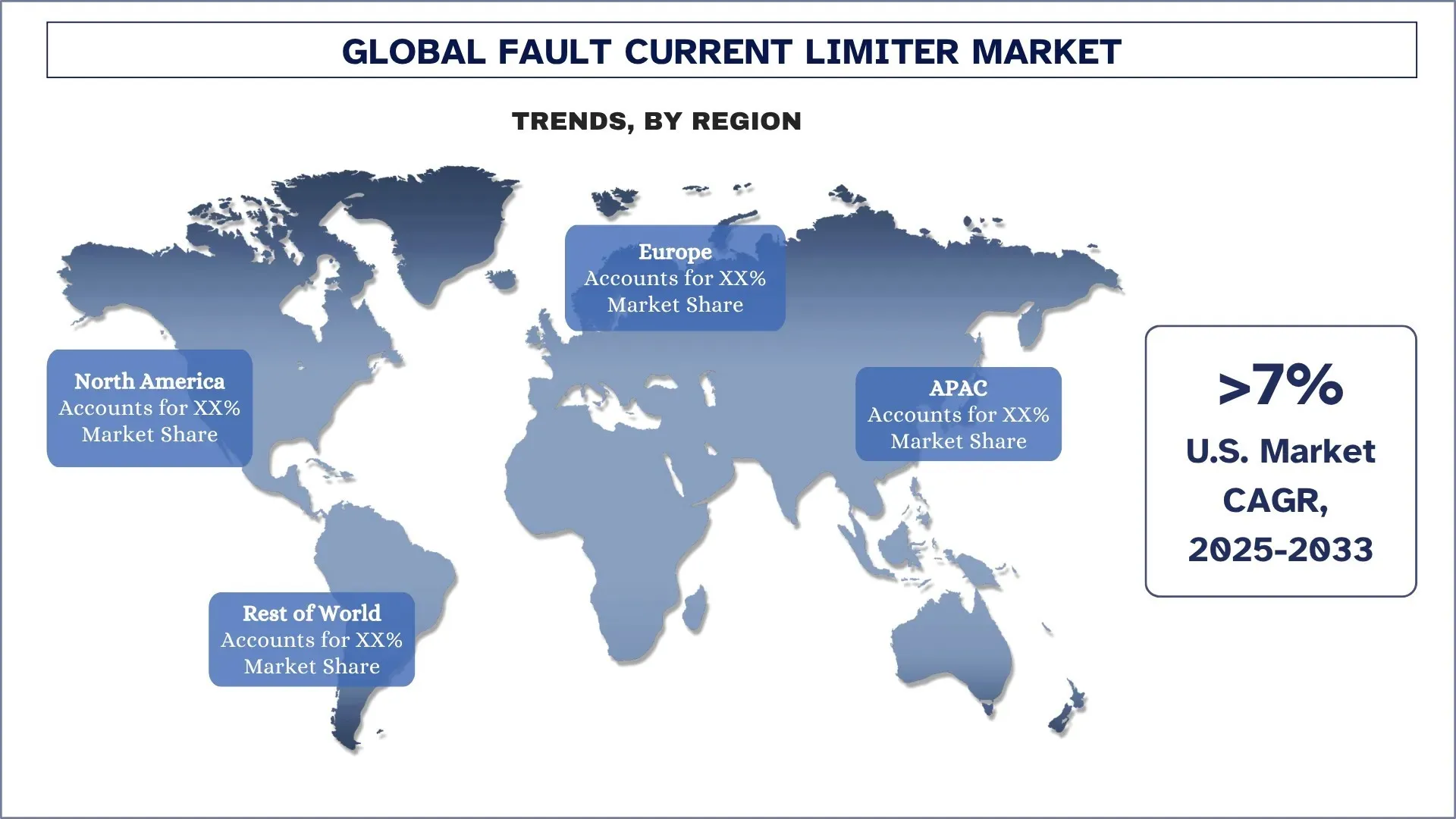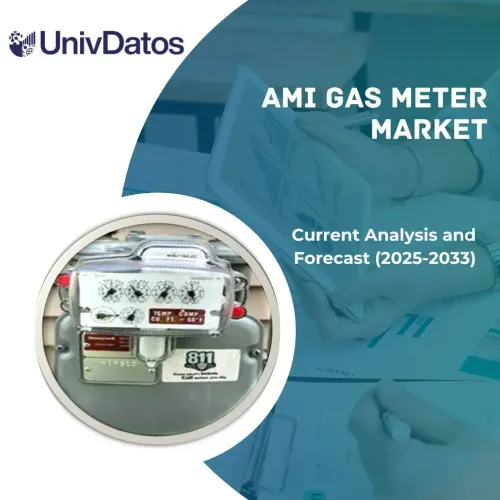- Home
- About Us
- Industry
- Services
- Reading
- Contact Us
Fault Current Limiter Market: Current Analysis and Forecast (2025-2033)
Emphasis on Type (Superconducting and Non-Superconducting); Voltage Range (High, Medium, and Low); End-Use (Power Stations, Oil & Gas, Automotive, Paper Mills, Chemicals, and Steel & Aluminum); and Region/Country

Global Fault Current Limiter Market Size & Forecast
The Global Fault Current Limiter Market was valued at USD 5.83 billion in 2024 and is expected to grow at a CAGR of around 7.17% during the forecast period (2025-2033F), driven by the growing demand for grid modernization & smart grid integration, along with the increased deployment of renewable energy.
Fault Current Limiter Market Analysis
The Fault Current Limiter (FCL) market is developing across the globe as the need to have improved grid stability, safety, and efficiency is growing increasingly. Fault Current Limiters (FCLs) are devices that prevent the damage that short circuits or fault currents can produce on an electrical system. These are used to avoid the saturation of networks, and such devices enable the continuity of power delivery over the networks. As electrical networks continue to grow more complex and interconnected, fault protection becomes an increasingly vital requirement, which is one of the factors that have accelerated the deployment of FCLs in new and existing infrastructure. Furthermore, grid modernization and the integration of renewable energy sources, due to the increased importance given to energy efficiency around the globe, have contributed to the need for advanced FCL technologies. The main advantages of FCLs can be noted as small circuit breaker size, less power disruption during the outage, improved grid resiliency, which makes the process very appealing to utility companies, industry, and renewable power systems integration. The market is continuing to grow, with material and technological advancements, including superconducting and hybrid FCLs, allowing even more efficient, cheaper, and scalable solutions.
Global Fault Current Limiter Market Trends
This section discusses the key market trends that are influencing the various segments of the global fault current limiter market, as found by our team of research experts.
Development of Solid-State and Superconducting FCLs
Rapid advancement in materials science and power electronics is being used to drive the development of Fault Current Limiter technology. Solid-state FCLs using fast-switching semiconductor devices are compact, with millisecond response and high reliability. In the meantime, superconducting FCLs employ the high-temperature superconductors (HTS) to provide zero-resistance in steady-state operation and current-limiting protection in fault situations. These technologies are also making protections smarter, smaller, and more efficient, tailored to AC and DC grids. The trend indicates a larger system-wide industry movement to minimize system loss, grid flexibility, and absorption of the boom in renewable attachment. In January 2025, the SuperGrid Institute in France carried out groundbreaking trials of a resistive superconducting FCL combined with a high voltage (50 kV DC) mechanical circuit breaker. In test conditions designed to replicate the conditions of possibly occurring in the real world, the SFCL attenuated a potential 43 kA surge to merely 5.5 kA prior to the breaker opening-a world first of any HV-DC protection system.
Fault Current Limiter Industry Segmentation
This section provides an analysis of the key trends in each segment of the global fault current limiter market report, along with forecasts at the global, regional, and country levels for 2025-2033.
The Non-superconducting Segment Dominates the Fault Current Limiter Market
Based on type, the fault current limiter market is segmented into superconducting and non-superconducting. In 2024, the non-superconducting segment dominated the market and is expected to maintain its lead through the forecast period. The non-superconducting fault current limiters are superior in terms of cost and efficiency to implement in a wide scope of applications, especially in the power grid and industrial, as well as renewable energy systems. Their efficiency in controlling high fault currents and their non-need for expensive cryogenic temperatures are additional motivators of their popularity. Moreover, the increased necessity of real-time protection and rapid fault detection, particularly in even more complex electrical grids, drives the demand for such devices further. The growing demand for grid stability, an increase in the integration of renewable energy, and the interest in cost-effective applications are likely to remain essential factors in propelling the demand for non-superconducting FCLs.
The High Voltage Category held the Largest Market Share in the Fault Current Limiter Market
Based on voltage range, the fault current limiter market is segmented into high, medium, and low. In 2024, the high segment held the largest share and is expected to remain at the top for the next few years. Fault current limiters are important in protecting electrical grids, especially in power stations, power transmission, and large industrial installations using high voltages. They are important in the prevention of equipment damage by fault currents, grid defenses, and reducing power cutoffs. The trend toward more complexity of the power transmission systems is combined with the rising need to have high-capacity, reliable networks, which is promoting high-voltage FCL dominance. The shift towards renewable energy, including offshore wind farms and solar plants, is also underway and requires stronger high-voltage solutions, which means dealing with larger and more fluctuating loads. The growing interconnection of long-distance transmission lines and smart grid technologies grows even further, driving the necessity of high-voltage fault current limiters. Since the world has been preoccupied with bringing its aging infrastructure to the latest level and securing the efficiency of large-scale power systems, high-voltage FCLs will retain their place as leaders in the market.

North America Dominated the Global Fault Current Limiter Market
North America has the biggest market share in the fault current limiters, and it is likely to continue dominating in this market throughout the forecast period. This is attributed to the continued emphasis on grid modernization, integrating renewable energy, and government programs to enhance power grid reliability in the region. Moreover, sustainability trends and the emission of carbon have promoted the positive growth of energy-efficient and grid-resilient technology such as FCLs. The existence of established energy giants, new technologies of FCL, and massive investments made in smart grid initiatives, among others, help make North America a market leader in the world. Moreover, the development of the electric vehicles (EVs) market and the following growth in the need for an efficient power distribution network are also likely to contribute to the expansion of FCLs in the region.
U.S. held a dominant Share of the North America Fault Current Limiter Market in 2024
The U.S. Fault Current Limiter (FCL) market is growing continuously due to the increase in demand for grid reliability, the integration of renewable sources, and the upgrading of old infrastructure. The amount of short-circuit risks posed by the addition of solar and wind plants, as well as the addition of electric vehicles, is making utilities push into more advanced fault protection. FCL is also facilitated by government initiatives in the smart grid with investments or investment incentives in high-voltage systems. The technologies that are considered to be rather promising due to their quick reaction and low energy consumption are the superconducting ones. With the threat to grid stability posed by extreme weather events, FCLs are assuming increasing importance in the durable, safe, and efficient distribution of power in both utility and manufacturing sectors.

Fault Current Limiter Industry Competitive Landscape
The global fault current limiter market is competitive, with several global and international market players. The key players are adopting different growth strategies to enhance their market presence, such as partnerships, agreements, collaborations, new product launches, geographical expansions, and mergers and acquisitions.
Top Fault Current Limiter Companies
Some of the major players in the market are Liaoning Rongxin Xingye Power Technology Co.,Ltd., American Superconductor, ABB, Schneider Electric, Nexans, Wilson Transformer Company, GridON Ltd., Eaton Corporation, GE Grid Solutions, LLC (GE Vernova), and LS ELECTRIC Co., Ltd.
Recent Developments in the Fault Current Limiter Market
In July 2024, LS Cable and System (LS C&S) and LS Electric introduced a superconducting internet data center (IDC) in the AI Era. They have intentions of vigorously venturing into both domestic and overseas markets, such as Vietnam. The superconducting solution has the capability to transmit high power capacity that is equal to 154kV, but at a reduced 22.9kV.
In July 2024, Huawei FusionSolar, a Global provider of solar solutions, introduced the biggest commercial and industrial (C&I) inverter it has offered to the market so far, a 150 kW high-power C&I inverter series. The former is solar PV only, whereas the latter needs an optimizer.
Global Fault Current Limiter Market Report Coverage
Report Attribute | Details |
Base year | 2024 |
Forecast period | 2025-2033 |
Growth momentum | Accelerate at a CAGR of 7.17% |
Market size 2024 | USD 5.83 Billion |
Regional analysis | North America, Europe, APAC, Rest of the World |
Major contributing region | North America is expected to dominate the market during the forecast period. |
Key countries covered | U.S., Canada, Germany, U.K., Spain, Italy, France, China, Japan, and India |
Companies profiled | Liaoning Rongxin Xingye Power Technology Co.,Ltd., American Superconductor, ABB, Schneider Electric, Nexans, Wilson Transformer Company, GridON Ltd., Eaton Corporation, GE Grid Solutions, LLC (GE Vernova), and LS ELECTRIC Co., Ltd. |
Report Scope | Market Trends, Drivers, and Restraints; Revenue Estimation and Forecast; Segmentation Analysis; Demand and Supply Side Analysis; Competitive Landscape; Company Profiling |
Segments Covered | By Type; By Voltage Range; By End-Use; By Region/Country |
Reasons to Buy Fault Current Limiter Market Report:
The study includes market sizing and forecasting analysis confirmed by authenticated key industry experts.
The report briefly reviews overall industry performance at a glance.
The report covers an in-depth analysis of prominent industry peers, primarily focusing on key business financials, type portfolios, expansion strategies, and recent developments.
Detailed examination of drivers, restraints, key trends, and opportunities prevailing in the industry.
The study comprehensively covers the market across different segments.
Deep dive regional-level analysis of the industry.
Customization Options:
The global fault current limiter market can further be customized as per the requirements or any other market segment. Besides this, UnivDatos understands that you may have your own business needs; hence, feel free to contact us to get a report that completely suits your requirements.
Table of Content
Research Methodology for the Global Fault Current Limiter Market Analysis (2023-2033)
We analyzed the historical market, estimated the current market, and forecasted the future market of the global fault current limiter market to assess its application in major regions worldwide. We conducted exhaustive secondary research to gather historical market data and estimate the current market size. To validate these insights, we carefully reviewed numerous findings and assumptions. Additionally, we conducted in-depth primary interviews with industry experts across the fault current limiter value chain. After validating market figures through these interviews, we used both top-down and bottom-up approaches to forecast the overall market size. We then employed market breakdown and data triangulation methods to estimate and analyze the market size of industry segments and sub-segments.
Market Engineering
We employed the data triangulation technique to finalize the overall market estimation and derive precise statistical numbers for each segment and sub-segment of the global fault current limiter market. We split the data into several segments and sub-segments by analyzing various parameters and trends, including type, voltage range, end-use, and regions within the global fault current limiter market.
The Main Objective of the Global Fault Current Limiter Market Study
The study identifies current and future trends in the global fault current limiter market, providing strategic insights for investors. It highlights regional market attractiveness, enabling industry participants to tap into untapped markets and gain a first-mover advantage. Other quantitative goals of the studies include:
Market Size Analysis: Assess the current market size and forecast the market size of the global fault current limiter market and its segments in terms of value (USD).
Fault Current Limiter Market Segmentation: Segments in the study include areas of type, voltage range, end-use, and regions.
Regulatory Framework & Value Chain Analysis: Examine the regulatory framework, value chain, customer behavior, and competitive landscape of the fault current limiter industry.
Regional Analysis: Conduct a detailed regional analysis for key areas such as Asia Pacific, Europe, North America, and the Rest of the World.
Company Profiles & Growth Strategies: Company profiles of the fault current limiter market and the growth strategies adopted by the market players to sustain the fast-growing market.
Frequently Asked Questions FAQs
Q1: What is the global fault current limiter market current market size and its growth potential?
The global fault current limiter market was valued at USD 5.83 billion in 2024 and is expected to grow at a CAGR of 7.17% during the forecast period (2025-2033).
Q2: Which segment has the largest share of the global fault current limiter market by type?
The non-superconducting segment dominated the market and is expected to maintain its leading position throughout the forecast period. This is due to the increased need for real-time protection and rapid fault detection, particularly in even more complex electrical grids, which further drives the demand for such devices.
Q3: What are the driving factors for the growth of the global fault current limiter market?
• Grid Modernization and Smart Grid Integration: Modern grids require advanced fault protection to handle bi-directional power flows, automation, and real-time control, making FCLs essential for ensuring system stability and operational safety.
• Increased Deployment of Renewable Energy: Renewables like wind and solar introduce unpredictable load patterns and fault current surges; FCLs help manage these fluctuations and protect grid infrastructure from damage during faults.
• Urbanization and Load Growth: Rising electricity demand in densely populated urban areas increases fault current levels; FCLs ensure safe and uninterrupted power supply while preventing equipment overload and short-circuit hazards.
Q4: What are the emerging technologies and trends in the global fault current limiter market?
• Development of Solid-State and Superconducting FCLs: There is growing R&D focus on compact, efficient, and fast-acting FCLs using solid-state electronics and high-temperature superconductors. These next-gen devices offer superior fault response, lower energy loss, and longer life cycles, making them ideal for modern power systems.
• Pilot Projects and Utility Collaborations: Utilities worldwide are partnering with technology providers and research institutes to test FCLs under real-world grid conditions. Successful pilot projects are accelerating commercial deployment and helping tailor FCL designs to regional infrastructure needs.
Q5: What are the key challenges in the global fault current limiter market?
• High Initial Costs and ROI Concerns: FCLs, especially superconducting types, involve significant upfront investment. Utilities often hesitate due to long payback periods and uncertain cost-benefit returns compared to conventional protection devices.
• Technical Complexity and Integration Issues: Integrating FCLs into existing grid infrastructure can be complex, requiring specialized knowledge, system reconfiguration, and compatibility with legacy protection schemes, posing barriers to widespread adoption.
Q6: Which region dominates the global fault current limiter market?
North America has the biggest market share in the fault current limiters, and it is likely to continue dominating in this market throughout the forecast period. This is attributed to the continued emphasis on grid modernization, integrating renewable energy, and government programs to enhance power grid reliability in the region. Moreover, sustainability trends and the emission of carbon have promoted the positive growth of energy-efficient and grid-resilient technology such as FCLs.
Q7: Who are the key players in the global fault current limiter market?
Some of the key companies include:
• Liaoning Rongxin Xingye Power Technology Co.,Ltd.
• American Superconductor
• ABB
• Schneider Electric
• Nexans
• Wilson Transformer Company
• GridON Ltd.
• Eaton Corporation
• GE Grid Solutions, LLC (GE Vernova)
• LS ELECTRIC Co., Ltd.
Q8: What roles do government initiatives and policy mandates play in accelerating the adoption of fault current limiters globally?
• Incentive Programs & Grants: Governments across the U.S., EU, and APAC offer funding and tax benefits for innovative grid projects, driving FCL adoption in modernization efforts.
• Grid Reliability Standards: Regulatory bodies like FERC, IEC, and CIGRÉ are enforcing stricter fault protection norms, compelling utilities to invest in FCLs.
• National Renewable Targets: Policy-driven clean energy targets increase fault variability, necessitating advanced current limiting technologies for stable grid operations.
Q9: How do supply chain dependencies influence the reliability and cost structure of fault current limiter production?
• Material Constraints: Dependence on rare or specialized materials like high-temperature superconductors can lead to price volatility and supply risks.
• Global Supplier Base: Key components are often sourced internationally, making the market vulnerable to geopolitical tensions, trade restrictions, or shipping delays.
• Localization Strategies: Manufacturers are shifting toward regional sourcing and vertical integration to stabilize costs and ensure uninterrupted production.
Related Reports
Customers who bought this item also bought










